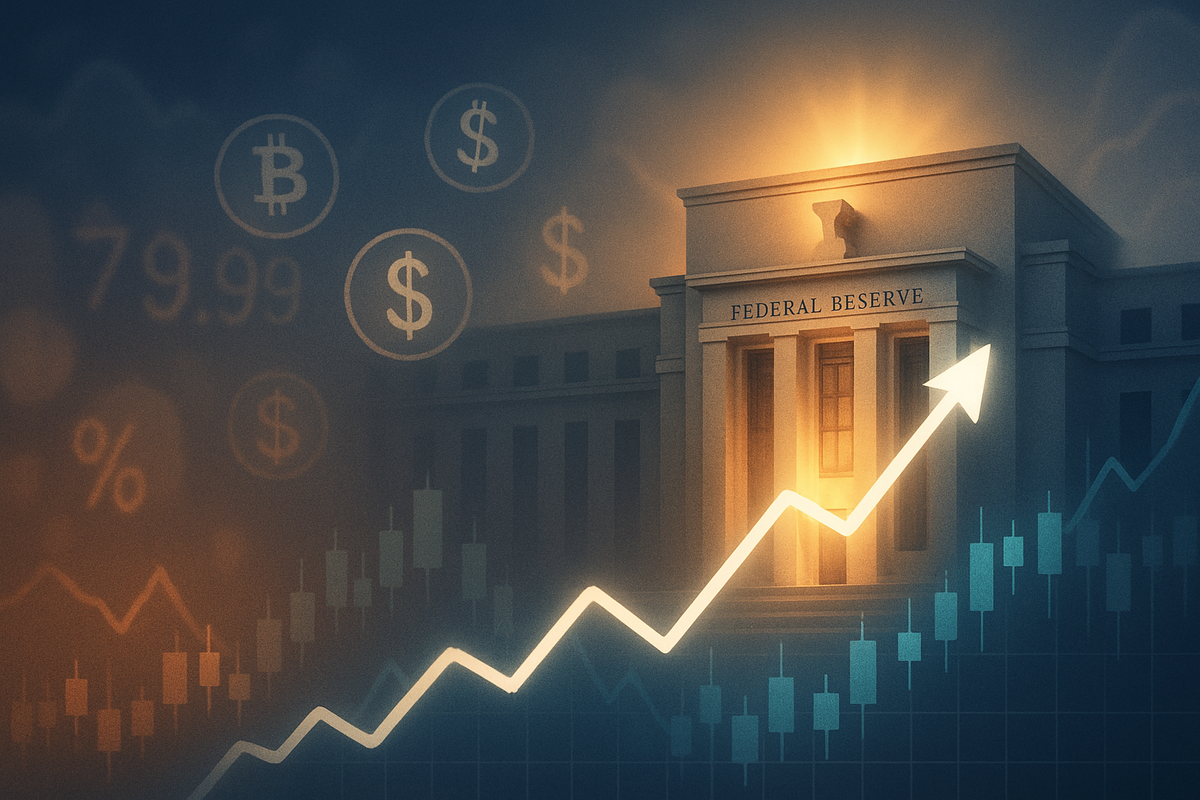Financial News
Federal Reserve Signals Further Easing: Market Cheers Rate Cuts Amidst Lingering Economic Jitters

Washington D.C. – October 8, 2025 – The Federal Reserve has decisively pivoted towards a more accommodative monetary policy, implementing its first interest rate cut of 2025 in September and setting the stage for further reductions. This shift, largely driven by concerns over a softening labor market and the imperative to prevent a potential rise in unemployment, has sent a wave of optimism through the stock market, with major indices scaling new historic highs. However, this bullish sentiment is delicately balanced against underlying economic jitters, including persistent inflation and the disruptive impact of an ongoing government shutdown.
Today's release of the September Federal Open Market Committee (FOMC) minutes is poised to offer critical insights into the central bank's internal deliberations, particularly regarding the necessity and timing of additional rate cuts. As investors eagerly dissect these documents, the prevailing expectation is for another 25 basis point cut at the upcoming October FOMC meeting, reinforcing the Fed's commitment to supporting economic stability even as it grapples with a complex and sometimes contradictory economic landscape.
Fed's Dovish Pivot Takes Center Stage as Market Anticipates Further Easing
The Federal Reserve initiated its current easing cycle with a 25 basis point interest rate cut in September 2025, bringing the federal funds rate to a range of 4.00%-4.25%. This move marked a significant departure from the restrictive policies of previous years, signaling the central bank's intent to inject liquidity and stimulate economic activity. The decision, though widely anticipated by market participants, was not entirely unanimous, with the September FOMC meeting minutes, released today, October 8, 2025, expected to detail an 11-1 vote in favor of the cut. Notably, newly appointed Governor Stephen Miran reportedly dissented, advocating for a more aggressive 50 basis point reduction.
The timeline of events leading to this moment has been characterized by evolving economic data and internal debates within the Fed. Throughout late 2024 and early 2025, a robust labor market and sticky inflation had kept the Fed on a tighter path. However, a gradual softening in employment figures and increasing concerns about a potential economic slowdown prompted a re-evaluation. Key players like Fed Chair Jerome Powell have consistently emphasized a data-dependent approach, while other FOMC members, including Christopher Waller and Michelle Bowman, have publicly supported future rate cuts. Conversely, Kansas City Fed Reserve Bank President Jeffrey Schmid, while voting for the September cut, has voiced concerns that further easing could reignite inflationary pressures. JPMorgan Global Research has also weighed in, forecasting two more Fed cuts in 2025.
Initial market reactions have been overwhelmingly positive. Major U.S. equity indices have surged, establishing fresh historic highs as investors embrace a "risk-on" mentality fueled by reduced borrowing costs and the perception of a supportive central bank. Short-term forecasts for the Dow Jones Industrial Average (DJIA) (NYSE: DIA) suggest continued upward momentum, with projections ranging between 47,000 and 48,000 by late 2025, largely attributed to anticipated Fed rate cuts and strong earnings from the technology sector. Concurrently, gold prices have soared, setting new records above $4,000 per ounce, reflecting a "dovish outlook" and a degree of market uncertainty that often drives demand for safe-haven assets. However, the ongoing U.S. government shutdown has cast a shadow, delaying crucial economic data, including the September employment survey, which could complicate the Fed's future policy deliberations and introduce an element of unpredictability into the market.
Corporate Fortunes Shift: Who Wins and Loses in a Dovish Fed Environment
The Federal Reserve's pivot to an accommodative monetary policy is set to reshuffle the deck for public companies, creating distinct winners and losers across various sectors. The most immediate beneficiaries are typically those sensitive to interest rates, particularly companies with high debt loads or those reliant on consumer financing. Conversely, sectors that thrived in a higher interest rate environment or those whose valuations are already stretched may face headwinds.
Technology companies, particularly those within the growth-oriented segments, are poised to be significant winners. Lower borrowing costs reduce the expense of funding innovation, expansion, and research and development, which are critical for their business models. Companies like Microsoft (NASDAQ: MSFT), Apple (NASDAQ: AAPL), and Amazon (NASDAQ: AMZN), which often carry significant debt for strategic investments and share buybacks, will see their interest expenses decrease, boosting profitability. Furthermore, the "risk-on" sentiment fostered by a dovish Fed tends to favor high-growth tech stocks, as investors become more willing to allocate capital to ventures with higher future earnings potential. The current research highlights strong earnings from the technology sector as a key driver for market growth, suggesting that these firms are already capitalizing on the changing environment.
On the other hand, the financial sector, particularly traditional banks, might face a more mixed outlook. While lower rates can stimulate loan demand, they also compress net interest margins – the difference between what banks earn on loans and what they pay on deposits. Large banks such as JPMorgan Chase (NYSE: JPM) and Bank of America (NYSE: BAC) could see their profitability squeezed if the yield curve flatens significantly. Additionally, companies in sectors that have benefited from higher interest rates, such as certain insurance providers or money market funds, may experience reduced returns. Real estate investment trusts (REITs) (NYSE: VNQ) could see a boost from lower mortgage rates stimulating housing demand, but their sensitivity to broader economic health and potential oversupply in certain markets remains a factor. Companies heavily reliant on stable, high-yield income streams might also struggle to find comparable returns in a lower-rate environment.
The current economic landscape, marked by persistent inflation expectations despite rate cuts, also introduces a layer of complexity. Companies that have strong pricing power and can pass on increased costs to consumers may be better positioned. However, those operating on thin margins in highly competitive sectors could find themselves squeezed between rising input costs and a consumer base potentially feeling the pinch of elevated inflation expectations. The ongoing government shutdown further complicates the picture, creating uncertainty that could disproportionately affect companies with significant government contracts or those sensitive to delayed regulatory approvals and economic data releases.
Broader Economic Canvas: Unpacking the Wider Significance of the Fed's Stance
The Federal Reserve's current monetary policy shift extends far beyond immediate market reactions, weaving into the broader tapestry of global economic trends, regulatory frameworks, and historical precedents. This pivot towards an accommodative stance signifies a strategic response to evolving economic conditions, aiming to navigate a path between sustaining growth and containing inflation.
Firstly, this event fits squarely into a broader global trend of central banks adjusting their policies in response to post-pandemic economic realities. Many economies are grappling with the aftershocks of supply chain disruptions, elevated inflation, and varying degrees of labor market tightness. The Fed's move sets a precedent and could influence other central banks to consider similar easing measures, particularly if global growth projections soften. The ripple effects on competitors and partners are substantial; lower U.S. interest rates can weaken the dollar, making American exports more competitive and potentially boosting the earnings of multinational corporations. Conversely, countries with tighter monetary policies might see their currencies strengthen against the dollar, impacting their trade balances and capital flows.
Regulatory and policy implications are also significant. The emphasis on data dependency, despite the current government shutdown delaying crucial economic releases, highlights the challenges policymakers face in making informed decisions. The internal disagreements within the FOMC, as revealed in the minutes, underscore the lack of a clear consensus, which could lead to more volatile policy communication in the future. Furthermore, the persistent elevation of inflation expectations (one-year ahead at 3.4% and five-year ahead at 3.0%) above the Fed's 2% target raises questions about the effectiveness of current tools and the potential for a prolonged period of above-target inflation. This could prompt future debates on the Fed's mandate and its approach to inflation targeting.
Historically, periods of Fed easing have often been associated with economic recovery or efforts to prevent recession. Comparing the current scenario to past easing cycles, such as those following the dot-com bust or the 2008 financial crisis, reveals both similarities and crucial differences. While lower rates generally stimulate investment and consumption, the current environment is unique due to the combination of high inflation expectations, significant government debt, and geopolitical uncertainties. The record-setting gold prices, surging past $4,000 per ounce, serve as a historical bellwether, often indicating investor apprehension about currency stability and a flight to safety during times of economic uncertainty, even amidst a generally bullish stock market. The sustainability of current AI valuations, as noted in the research, also echoes past market bubbles, warranting careful scrutiny.
The Road Ahead: Navigating Uncertainty and Opportunity
As the Federal Reserve embarks on a path of monetary easing, the coming months are poised to be a period of both significant opportunity and considerable challenge for the financial markets. Investors and businesses will need to carefully navigate the evolving landscape, adapting their strategies to capitalize on emerging trends while mitigating potential risks.
In the short term, the market's attention will be fixated on two key events: the anticipated 25 basis point rate cut at the upcoming Federal Open Market Committee (FOMC) meeting on October 29, 2025, and Federal Reserve Chair Jerome Powell's upcoming speech on Thursday, October 9, 2025. Any hints of policy direction from Powell will be meticulously scrutinized, influencing currency markets, gold prices, and global equities. The ongoing U.S. government shutdown, which has delayed critical economic data, adds a layer of uncertainty, making the Fed's data-dependent approach more challenging and potentially leading to increased market volatility until the data flow normalizes. Companies will need to prepare for continued shifts in borrowing costs and consumer spending patterns, adjusting their capital expenditure plans and pricing strategies accordingly.
Looking further ahead, the long-term possibilities hinge on the Fed's ability to achieve a "soft landing" – bringing inflation down to its 2% target without triggering a significant economic downturn or a surge in unemployment. Potential strategic pivots for corporations include focusing on cost efficiencies to counteract persistent inflation, investing in technological advancements to boost productivity, and diversifying supply chains to enhance resilience against geopolitical shocks. Market opportunities may emerge in sectors that benefit from lower long-term interest rates, such as infrastructure development or renewable energy, which often require substantial upfront capital. Conversely, challenges include the sustainability of current valuations in high-growth sectors like artificial intelligence (AI), potential governmental fiscal challenges, and the risk of inflation remaining stubbornly above target, forcing the Fed to reverse course on its easing policy. Scenarios range from a sustained period of moderate growth with controlled inflation to a more turbulent environment marked by stagflation or a deeper economic contraction if policy missteps occur.
Market's New Horizon: A Summary of Key Takeaways and Future Outlook
The Federal Reserve's recent pivot to an accommodative monetary policy marks a significant inflection point for financial markets, signaling a clear intent to support economic growth through lower interest rates. The September 25 basis point cut and the strong anticipation of further reductions have fueled a "risk-on" environment, propelling major stock indices to new historic highs and driving gold prices to record levels above $4,000 per ounce. This shift is a direct response to a softening labor market and concerns over economic deceleration, even as inflation expectations remain elevated above the Fed's 2% target.
Moving forward, the market's trajectory will largely be dictated by the Fed's continued adherence to its data-dependent approach, particularly as the ongoing government shutdown disrupts the flow of crucial economic indicators. Investors should closely monitor upcoming Fed communications, including Chair Powell's speeches and future FOMC minutes, for any nuanced shifts in policy guidance. The interplay between easing monetary conditions, persistent inflation, and the resilience of corporate earnings will be critical in shaping the market's direction. While technology and growth stocks are poised to benefit from lower borrowing costs, traditional financial institutions and companies with limited pricing power may face headwinds.
The lasting impact of this policy shift will depend on the Fed's ability to delicately balance stimulating growth with taming inflation. A successful navigation of these challenges could usher in a period of sustained economic expansion, albeit with continued vigilance against inflationary pressures. Conversely, missteps could lead to renewed volatility and economic uncertainty. Investors in the coming months should watch for changes in inflation data, the resolution of the government shutdown, corporate earnings reports (especially from the technology sector), and any signs of a significant slowdown in the labor market. The current environment demands a nuanced approach, recognizing both the opportunities presented by a dovish Fed and the inherent risks that persist in a complex global economy.
This content is intended for informational purposes only and is not financial advice
More News
View More





Quotes delayed at least 20 minutes.
By accessing this page, you agree to the following
Privacy Policy and Terms Of Service.



